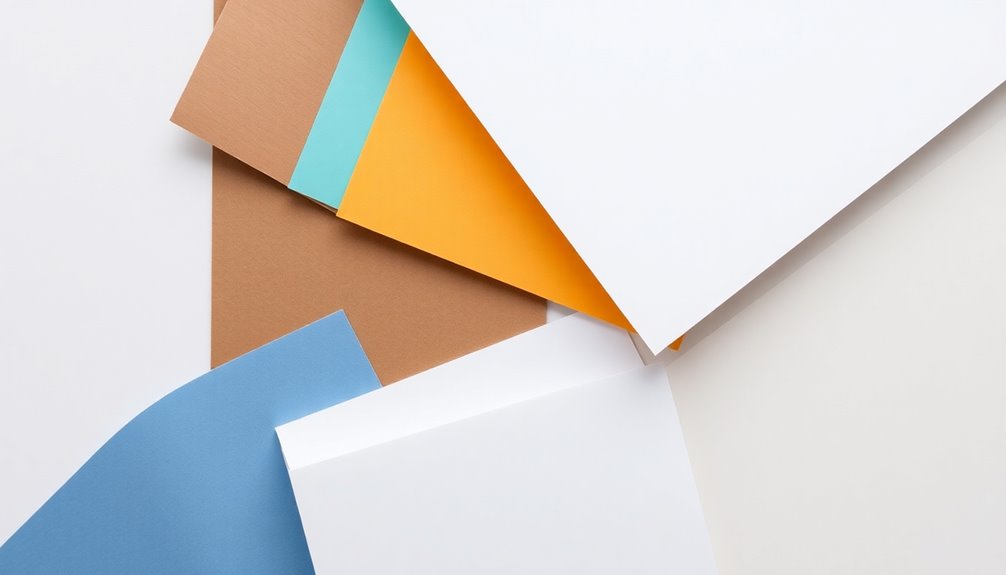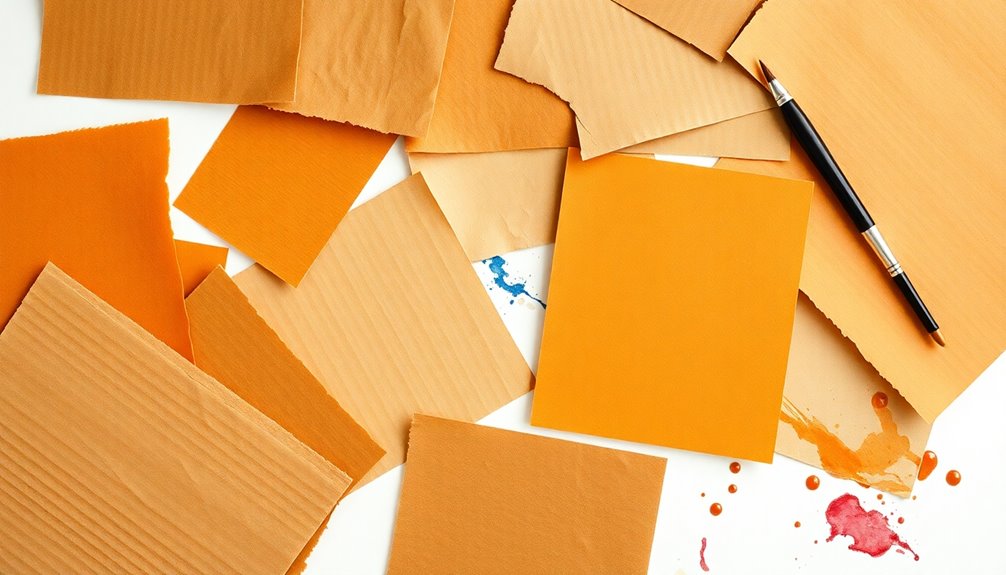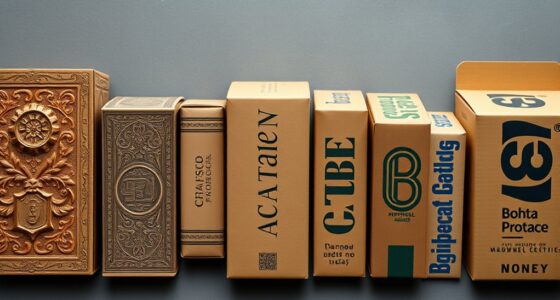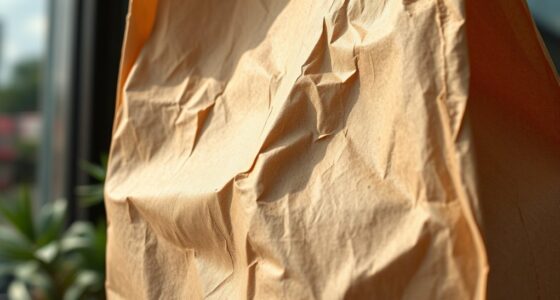When you think about types of paper, you'll find a wide variety to choose from. Copy paper is perfect for everyday use, while bond paper suits formal documents. Cardstock is great for crafting, and construction paper injects color into school projects. For specific tasks, specialty paper like watercolor paper enhances your artwork. If you're into packaging, options like kraft and wrapping paper are ideal. Eco-friendly choices, made from recycled materials, support sustainable practices. With so many types available, you're equipped to pick the right one for your needs. Explore further to uncover even more fascinating details about paper types!
Key Takeaways
- Copy Paper: Standard paper used for everyday tasks, typically available in 20 to 24-pound weights.
- Bond Paper: Heavier and smoother, ideal for formal documents and professional printing.
- Cardstock: Thicker paper ranging from 45 to 200 pounds, perfect for crafting and business cards.
- Construction Paper: Colorful and robust, primarily used in schools for art projects and creative activities.
- Specialty Papers: Unique papers designed for specific purposes, such as watercolor or high-quality writing, enhancing visual appeal and functionality.
Definition of Paper

When you think about paper, you're imagining a thin sheet material made mostly of cellulose fibers sourced from plants like wood and grasses.
This versatile product has evolved from hand production to modern machine manufacturing, enabling a wide range of types to meet different needs. The composition of paper includes various additives that enhance its properties, like brightness, opacity, and durability, making it suitable for a variety of applications.
Different types of paper vary in thickness, weight, texture, and color.
These characteristics play a significant role in determining how paper performs in specific tasks, whether you're printing documents, crafting, or packaging goods. For instance, heavier paper often offers a more luxurious feel, while lighter paper might be ideal for everyday printing.
The texture can influence how ink adheres, affecting the final appearance of printed materials.
General Paper Types
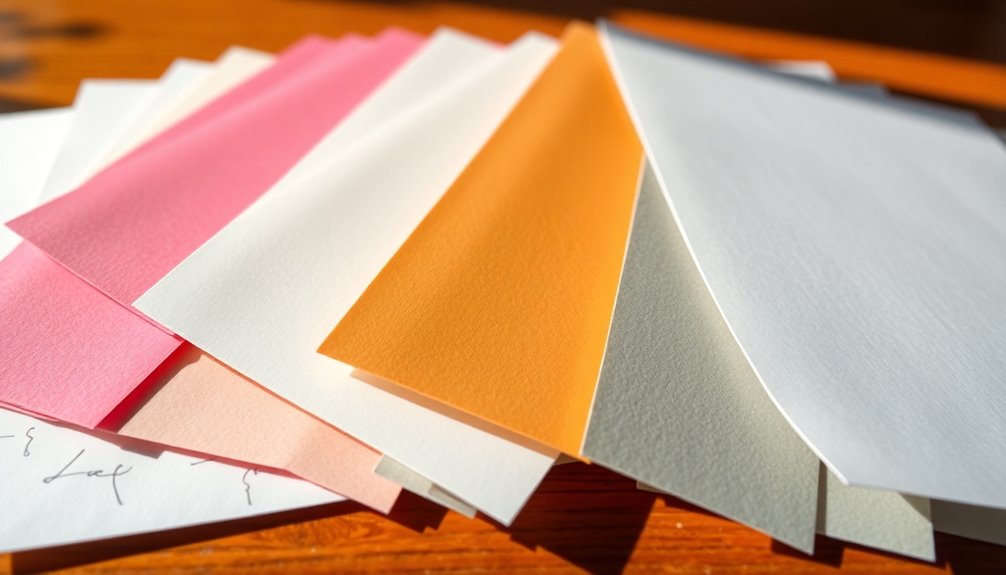
Paper comes in a variety of types, each tailored for specific uses and characteristics.
You'll find that copy paper is a staple in offices, available in standard sizes and weights, perfect for everyday printing and copying tasks. If you need something more formal, bond paper offers a smooth finish and comes in heavier weights, ideal for letterheads and important documents.
When it comes to crafting, cardstock is your go-to. Its thickness ranges from 45 to 200 pounds, making it perfect for invitations and sturdy projects.
For colorful and creative projects, construction paper is a favorite, often used in schools for art and craft activities.
If you're working on artistic endeavors, specialty papers like watercolor paper are designed for high absorbency and various textures, catering to different mediums. Glossy paper is great for printing photos, providing vibrant colors and a shiny finish.
You might also explore textured paper for an elegant touch in invitations or cards. Durable paper types, including heavy utility options, offer strength for various applications, ensuring your projects stand the test of time.
Each type serves a unique purpose, so choose wisely based on your needs!
Printing and Copy Paper

Choosing the right printing and copy paper can greatly impact the quality of your printed materials. You'll find various options available, from standard copy paper to specialty printing papers. Standard copy paper typically ranges from 20-pound to 24-pound weight and comes in common sizes like letter and legal. If you need vibrant images and sharp text, consider higher quality printing papers with glossy or matte finishes, perfect for marketing materials and presentations.
It's essential to guarantee compatibility with your printer type, whether it's inkjet or laser, as this directly affects print quality and performance. For creative projects, specialty printing papers such as cardstock and photo paper offer added weight and texture, enhancing visual appeal and durability.
Here's a quick overview:
| Type of Paper | Purpose |
|---|---|
| Standard Copy Paper | Everyday printing |
| Higher Quality Papers | Marketing materials, presentations |
| Specialty Papers | Creative projects, photos |
Specialty Writing Papers
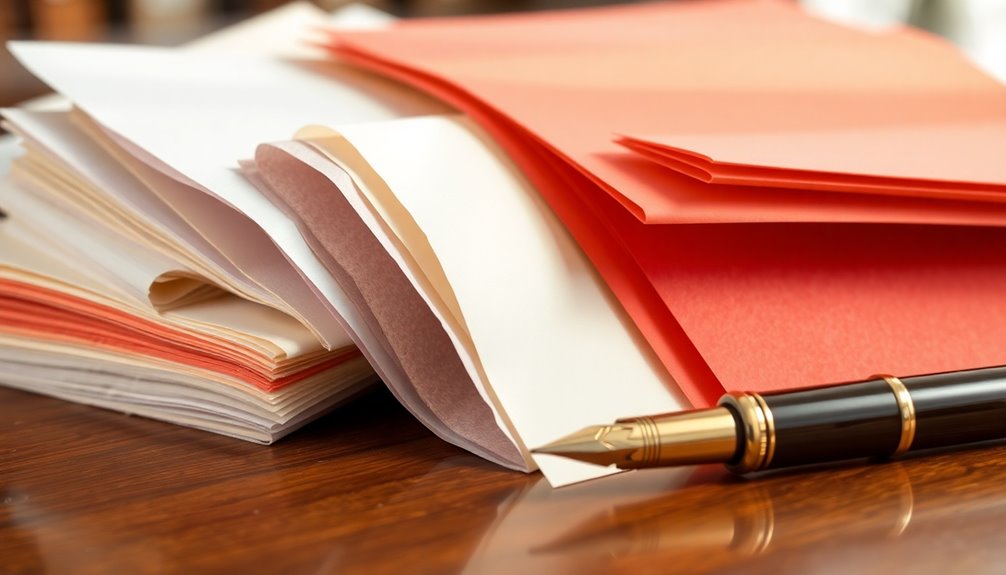
Specialty writing papers offer a range of unique qualities that elevate your writing projects. Whether you're crafting a formal letter or an artistic piece, these papers can enhance both the appearance and longevity of your work.
Here are some features that make specialty writing papers stand out:
- High-quality writing paper with durability
- Unique textures that add character
- Smooth finish for a refined look
- Acid-free specialty papers for archival purposes
- Linen and laid options for distinct printed materials
Consider bond paper for its robust nature, perfect for official documents. Blotting paper is your go-to for preventing smudges in art and calligraphy, while tracing paper allows for precise replication of designs.
The unique textures found in linen and laid options not only enhance aesthetics but also provide a tactile experience that standard papers can't match. Plus, acid-free specialty papers guarantee that your important documents remain in pristine condition, free from yellowing over time.
Embrace the versatility of specialty writing papers to make your projects truly shine!
Craft and Packaging Papers
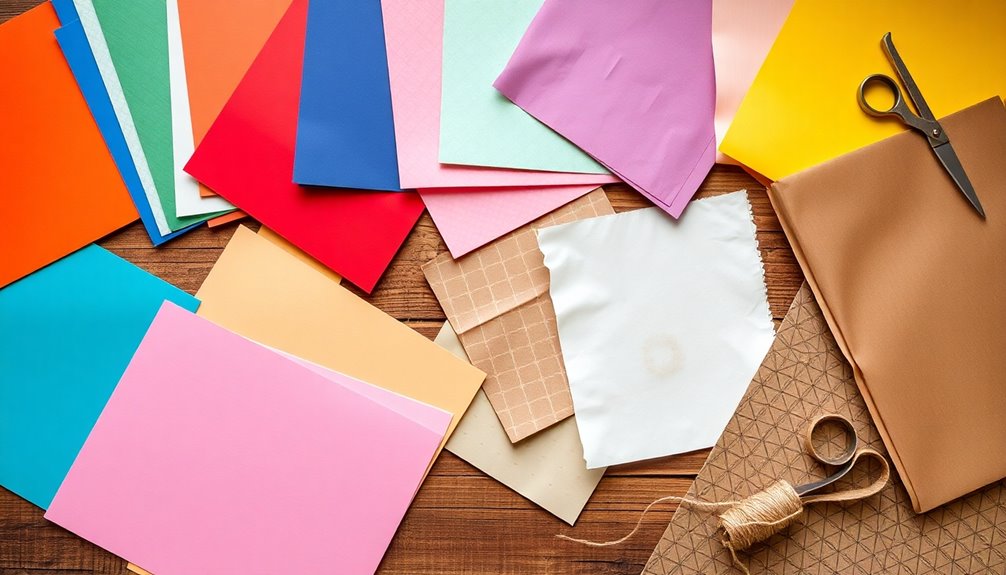
When it comes to crafting and packaging, the right type of paper can make all the difference. One standout option is Kraft Paper. Made from wood pulp, it's both durable and biodegradable, making it perfect for packaging, envelopes, and bags.
If you need something lightweight, Tissue Paper is ideal for wrapping delicate items and adds a touch of elegance to gift wrapping and crafting projects.
For a decorative touch, wrapping paper comes in various designs and weights, enhancing the aesthetic appeal of your gifts. It's a great way to make your presents stand out.
On the other hand, if you're looking for something moisture-resistant, consider Wax Paper. Coated with paraffin, it's perfect for protecting your items from moisture while also being useful in various crafting applications.
Each of these papers serves a unique purpose in crafting and packaging. Whether you choose the strength of Kraft Paper or the delicacy of Tissue Paper, knowing the right paper for your project guarantees you get the best results.
Food and Baking Papers

In the world of culinary creations, selecting the right paper can elevate your cooking and baking experience. Parchment Paper stands out as a kitchen essential, providing a smooth, non-stick surface ideal for lining baking pans and wrapping food.
It's grease-resistant and moisture-resistant, making it perfect for various cooking tasks.
Here are some other key food and baking papers you should consider:
- Wax Paper: Moisture-resistant but not for baking; it can melt at high temperatures.
- Butcher Paper: Strong and absorbent, great for wrapping meat and fish while allowing breathability.
- Freezer Paper: Coated on one side, it's designed to prevent freezer burn and keep food fresh.
- Cake Boards: Sturdy bases for cakes and pastries, ensuring safe transport and presentation.
- Baking Mats: Reusable silicone alternatives to parchment, providing a non-stick surface.
Business and Administrative Paper
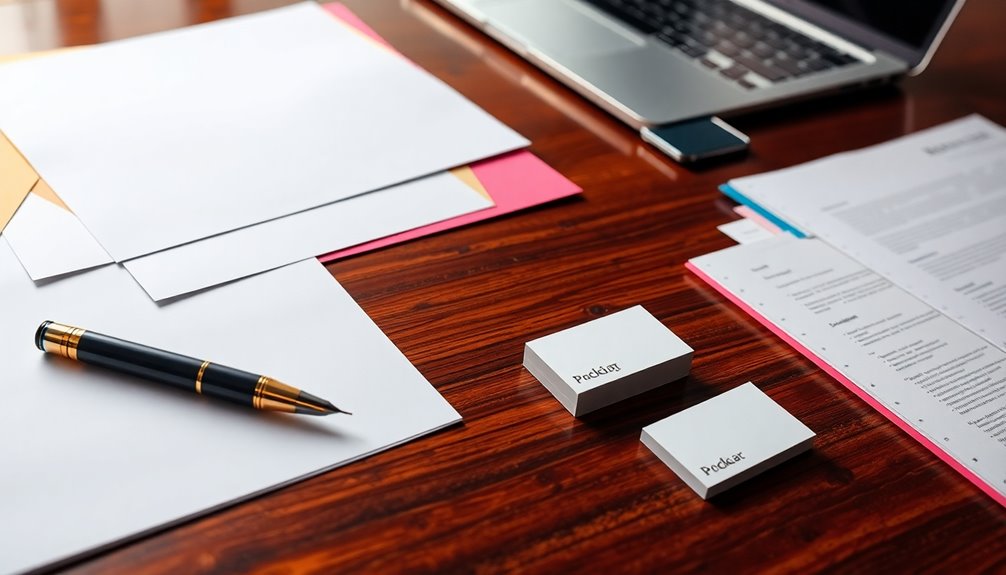
Efficiency in business operations often hinges on the right choice of paper. When it comes to handling administrative tasks, Business Form Paper is essential for printing invoices and receipts, guaranteeing you maintain organized documentation and accurate records.
You'll find that using durable File Folders helps keep important documents neatly organized and easily accessible, which is vital for smooth operations.
For your official correspondence, Letterhead paper adds a professional touch, enhancing your brand image and credibility. It's typically heavier and designed to make a lasting impression.
If you often need multiple copies of documents, Carbonless paper is a game changer; it allows you to create duplicates without the hassle of carbon paper, which streamlines your invoicing and record-keeping.
Lastly, consider using Specialty papers, like security paper that incorporates watermarks or thermochromic ink, to bolster document security and prevent counterfeiting.
Environmental Considerations

When you choose paper, consider the environmental impact of your options.
Sustainable sourcing practices and eco-friendly alternatives can greatly reduce waste and conserve resources.
Sustainable Sourcing Practices
Sustainable sourcing practices in paper production are crucial for minimizing environmental impact and promoting responsible consumption. By focusing on eco-friendly practices, you can help create a demand for products that protect our planet.
Here are some key aspects of sustainable sourcing in paper:
- Use of FSC certified materials to guarantee responsible forest management.
- Incorporation of recycled paper, which reduces the need for virgin fiber.
- Adoption of alternative fibers like bamboo, hemp, and agricultural residues, minimizing deforestation.
- Growing market for recycled paper driven by consumer demand for environmentally responsible products.
- Encouragement of manufacturers to adopt greener practices through increased awareness.
When you choose paper products that follow these sustainable sourcing methods, you contribute to a healthier environment.
Recycled paper can contain up to 100% post-consumer waste, greatly cutting down landfill contributions. Additionally, focusing on alternative fibers helps lower the carbon footprint associated with traditional wood pulp sourcing.
Embracing these practices not only benefits you as a consumer but also plays a crucial role in promoting broader environmental conservation efforts.
Make informed choices, support sustainable sourcing, and help drive change in the paper industry.
Recycling and Waste Reduction
Recycling paper not only cuts down on waste but also plays an essential role in conserving our planet's resources. When you participate in recycling programs, you help reduce landfill waste considerably.
In fact, recycling a ton of paper can save 17 trees, 7,000 gallons of water, and 4,100 kilowatts of electricity. By choosing recycled paper, you actively contribute to conserving natural resources while minimizing the energy to produce new materials. It takes 60% less energy to create recycled paper than to start from virgin fibers.
Moreover, recycling paper helps lower greenhouse gas emissions by about 40% compared to producing new paper. With the global paper recycling rate hovering around 58%, there's still room for improvement.
Many countries are ramping up their efforts, encouraging more people to get involved in recycling programs. By doing so, we can achieve a reduction of up to 70% in paper waste, fostering a more sustainable environment for future generations.
Eco-Friendly Paper Alternatives
Finding alternatives to traditional paper has become increasingly important as we look for ways to lessen our environmental impact. By choosing eco-friendly paper options, you not only contribute to a healthier planet but also support sustainable practices.
Here are some key benefits of switching to eco-friendly papers:
- Made from post-consumer waste, reducing the need for virgin fibers
- FSC Certified Paper promotes sustainable forestry and biodiversity
- Lower carbon emissions during production compared to traditional methods
- High quality and performance standards for printing and packaging
- Supports green initiatives embraced by businesses and consumers alike
Recycled paper stands out as a popular choice, offering a viable alternative without compromising quality. It's perfect for various applications, from stationery to packaging.
Additionally, when you opt for FSC Certified Paper, you're ensuring that your paper products come from responsibly managed forests. This helps preserve our natural resources and promotes biodiversity.
As the demand for eco-friendly options grows, businesses are increasingly prioritizing these sustainable alternatives. You can play a part in this positive change by choosing paper products that align with your values and contribute to a healthier environment.
Frequently Asked Questions
How Many Paper Types Are There?
There are countless paper types available, each serving different purposes.
You'll find common categories like printing and writing papers, along with craft and packaging options.
Specialty papers, such as vellum and tissue, cater to specific creative needs.
As you explore, you'll notice new types emerging regularly, reflecting consumer demands and environmental concerns.
Understanding the range of paper can really help you make informed choices for your personal, creative, and professional projects.
What Are the 10 Uses of Paper?
You can use paper in a variety of ways. For instance, you might print documents, take notes, or craft artistic projects.
It's also great for packaging items securely, creating brochures for your business, or writing letters. You could even use it for wrapping gifts or making cards.
Additionally, paper serves as a canvas for artists and as a medium for school assignments. Its versatility makes it an essential part of everyday life.
What Type of Paper Is Most Commonly Used?
When you're looking for the most commonly used type of paper, copy paper usually tops the list.
It's versatile, available in standard sizes like letter and legal, and typically weighs between 20 to 24 pounds.
You'll find it in homes and offices alike, perfect for printing documents or making copies.
With brightness ratings ranging from 92 to 96, it guarantees your prints look sharp and professional every time you use it.
What Is Good Quality Paper Called?
Good quality paper's often called "bond paper," made from high-quality materials like cotton or rag pulp.
You'll notice it's durable and prints beautifully.
If you want something unique, specialty papers like vellum or watercolor paper also fall into the high-quality category.
Look for features like acid-free content to prevent yellowing, and consider coated papers for vibrant images.
When you choose wisely, you guarantee your projects stand out and last.
Conclusion
To sum up, understanding the different types of paper helps you choose the right one for your needs, whether you're printing documents, crafting, or packaging. Each type serves a unique purpose, and being aware of these can enhance your projects and save you time and resources. Plus, considering environmental factors when selecting paper can make a positive impact. So, next time you need paper, remember the variety available and pick the one that fits your requirements best!

